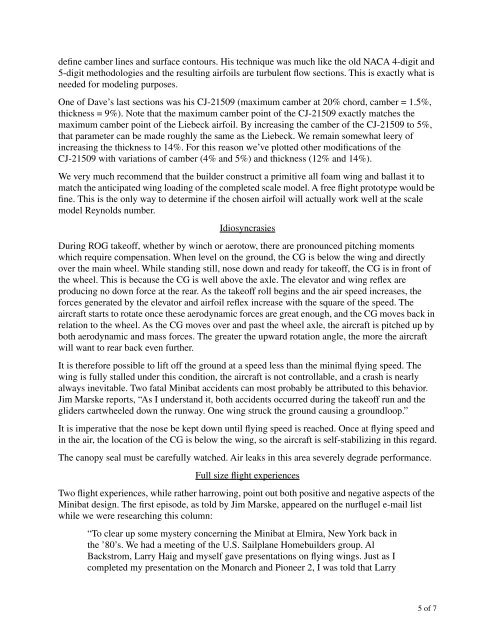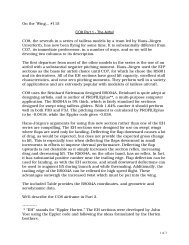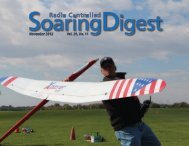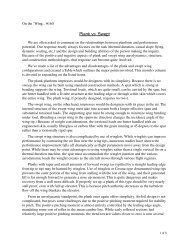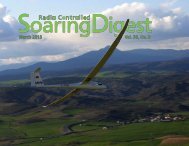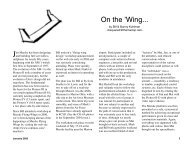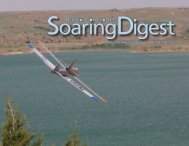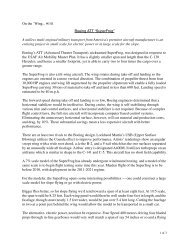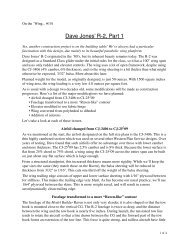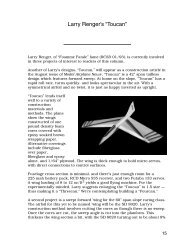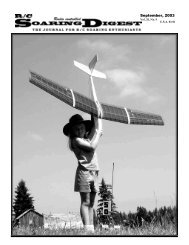Larry Haig's Minibat - Radio Controlled Soaring Digest
Larry Haig's Minibat - Radio Controlled Soaring Digest
Larry Haig's Minibat - Radio Controlled Soaring Digest
- No tags were found...
Create successful ePaper yourself
Turn your PDF publications into a flip-book with our unique Google optimized e-Paper software.
define camber lines and surface contours. His technique was much like the old NACA 4-digit and5-digit methodologies and the resulting airfoils are turbulent flow sections. This is exactly what isneeded for modeling purposes.One of Dave’s last sections was his CJ-21509 (maximum camber at 20% chord, camber = 1.5%,thickness = 9%). Note that the maximum camber point of the CJ-21509 exactly matches themaximum camber point of the Liebeck airfoil. By increasing the camber of the CJ-21509 to 5%,that parameter can be made roughly the same as the Liebeck. We remain somewhat leery ofincreasing the thickness to 14%. For this reason we’ve plotted other modifications of theCJ-21509 with variations of camber (4% and 5%) and thickness (12% and 14%).We very much recommend that the builder construct a primitive all foam wing and ballast it tomatch the anticipated wing loading of the completed scale model. A free flight prototype would befine. This is the only way to determine if the chosen airfoil will actually work well at the scalemodel Reynolds number.IdiosyncrasiesDuring ROG takeoff, whether by winch or aerotow, there are pronounced pitching momentswhich require compensation. When level on the ground, the CG is below the wing and directlyover the main wheel. While standing still, nose down and ready for takeoff, the CG is in front ofthe wheel. This is because the CG is well above the axle. The elevator and wing reflex areproducing no down force at the rear. As the takeoff roll begins and the air speed increases, theforces generated by the elevator and airfoil reflex increase with the square of the speed. Theaircraft starts to rotate once these aerodynamic forces are great enough, and the CG moves back inrelation to the wheel. As the CG moves over and past the wheel axle, the aircraft is pitched up byboth aerodynamic and mass forces. The greater the upward rotation angle, the more the aircraftwill want to rear back even further.It is therefore possible to lift off the ground at a speed less than the minimal flying speed. Thewing is fully stalled under this condition, the aircraft is not controllable, and a crash is nearlyalways inevitable. Two fatal <strong>Minibat</strong> accidents can most probably be attributed to this behavior.Jim Marske reports, “As I understand it, both accidents occurred during the takeoff run and thegliders cartwheeled down the runway. One wing struck the ground causing a groundloop.”It is imperative that the nose be kept down until flying speed is reached. Once at flying speed andin the air, the location of the CG is below the wing, so the aircraft is self-stabilizing in this regard.The canopy seal must be carefully watched. Air leaks in this area severely degrade performance.Full size flight experiencesTwo flight experiences, while rather harrowing, point out both positive and negative aspects of the<strong>Minibat</strong> design. The first episode, as told by Jim Marske, appeared on the nurflugel e-mail listwhile we were researching this column:“To clear up some mystery concerning the <strong>Minibat</strong> at Elmira, New York back inthe ’80’s. We had a meeting of the U.S. Sailplane Homebuilders group. AlBackstrom, <strong>Larry</strong> Haig and myself gave presentations on flying wings. Just as Icompleted my presentation on the Monarch and Pioneer 2, I was told that <strong>Larry</strong>5 of 7


